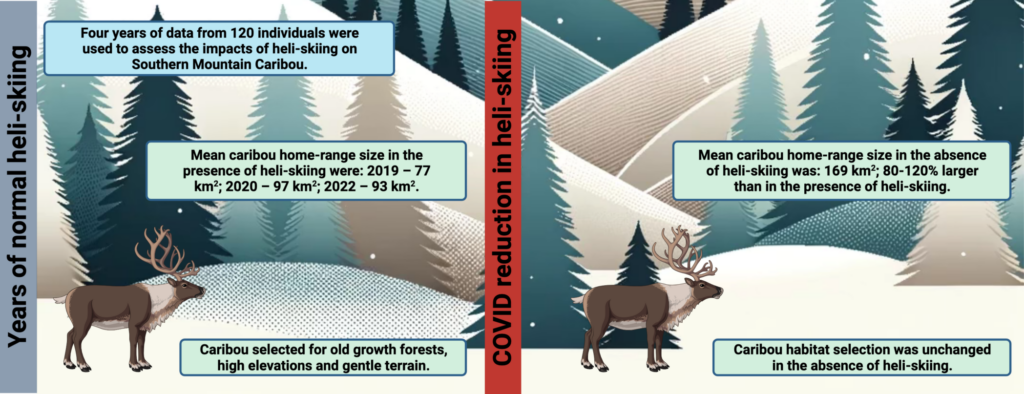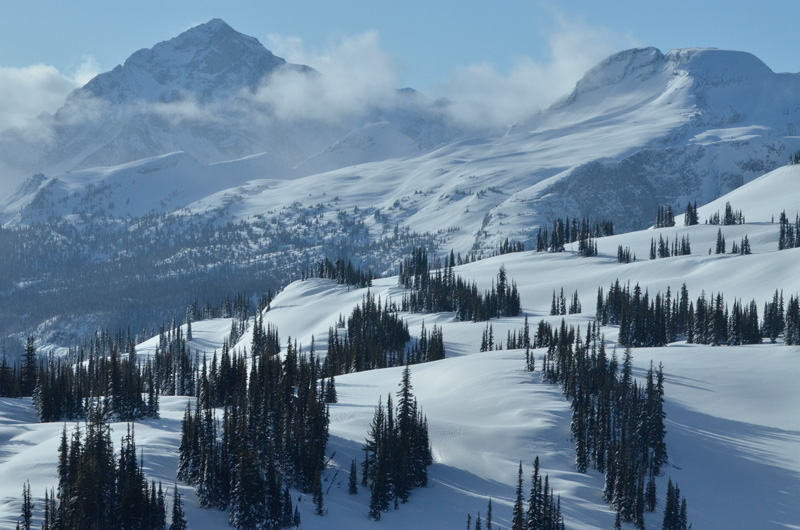Southern mountain caribou are a population of woodland caribou that commonly use high-elevation forests in late winter and summer. Southern mountain caribou are listed as Threatened under the federal Species at Risk Act and are declining across their range, though some herds are doing better than others. Actions to recover and improve caribou habitat generally only consider the physical environment, however, how humans use that environment is an important dimension to recovery planning. High-quality, value-neutral data on caribou herds and their environments is essential to disentangle the myriad factors behind the success or decline of populations and thus enable effective decision-making.
In winter, southern mountain caribou occupy high-elevation forests that are also ideal for heli-skiing. Heli-skiing (helicopter-based backcountry skiing) operations cover 40,000 km2 in the southern interior of BC. During the winter of 2020–21, BC introduced regional travel restrictions that led to an unprecedented 84% drop in heli-skiing days compared to previous years. Previous research by Nicola Freeman had shown physiological responses in caribou to heli-skiing and snowmobiling; the travel restrictions provided a unique situation—the “anthropause”—that allowed researchers to study how caribou responded to changes in human presence on the landscape.
In a new paper, researchers used location data from 120 caribou fitted with GPS collars to study changes in home range size, movement rates, and resource selection. They compared three late winter periods of normal heli-ski operations (2018/2019, 2019/2020, and 2021/2022) to a late winter with reduced heli-ski activity (2020/2021); late winter is when caribou are “range residents”, so any changes in movement attributed to disturbance could be differentiated from those due to their normal migration patterns. The study focused on three geographic areas: the herds to the east of Prince George (the “Hart Ranges”) and the Columbia North and Central Selkirks herds near Revelstoke.
The authors found that caribou home ranges increased in area by 80–120% during the year of reduced heli-skiing; on average, home ranges doubled in size. Caribou consistently preferred high elevations, lower-angle slopes, and older forests in every late winter period in the study. As resource selection did not change despite the increase in home range size, caribou access to a greater extent of their preferred environment may be constrained during years of normal heli-ski operations. This potential restriction of resources could negatively affect caribou body condition or survival.

These results suggest that during years of normal heli-ski operations (and likely by extension other forms of backcountry recreation and human activity), southern mountain caribou experience significant home range reductions, likely in an effort to reduce their encounters with these activities. While human recreation alone is not the sole driver of trends in caribou populations, this research provides evidence that we should consider the impacts of human recreation in resource planning. Further study with additional data on caribou demographics and human activities is essential to determine a path forward for the long-term coexistence of humans and caribou in the mountains.
